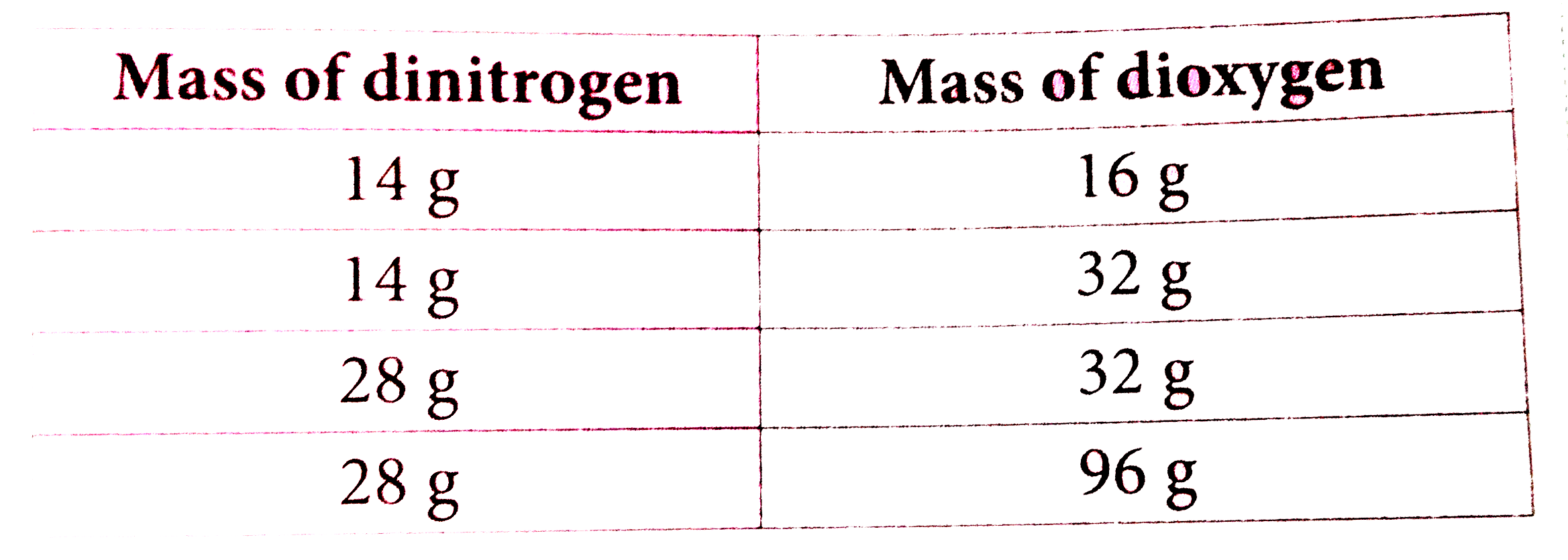The following data are obtained when dinitrogen and dioxygen react together to form different compounds:
Mass of dinitrogen Mass of dioxygen(i)14g16g(ii)14g32g(iii)28g32g(iv)28g80g
(a) Which law of chemical combination is obeyed by the above experimental data? Give its statement.
(b) Fill in the blanks in the following conversions:
(i) 1 km = ...................... mm = ...................... pm
(ii) 1 mg = ...................... kg = ...................... ng
(iii) 1 mL = ...................... L = ...................... dm3
Fixing the mass of dinitrogen as 28g, masses of dioxygen combined will be 32,64,32, and 80g in the given four oxides. These are in the ratio 1:2:1:5 which is a simple whole number ratio. Hence, the given data obey the law of multiple proportions.
b. i. 1km=1km×1000m1km×100cm1m×10mm1cm=106mm
1km=1km×1000m1km×1pm10−12m=1015pm
ii. 1mg=1mg×1g1000mg×1kg1000g=10−6kg
1mg=1mg×1g1000mg×1ng10−9g=106ng
iii. 1mL=1mL×1L1000mL=10−3L
1mL=1cm3
=1cm3×1dm×1dm×1dm10cm×10cm×10cm=10−3dm3
Topper's Solved these Questions
- NCERT BASED EXERCISEBOOK - CENGAGE CHEMISTRY ENGLISHCHAPTER - NCERT BASED EXERCISEEXERCISE - Redox Reaction
25 Videos
- NCERT BASED EXERCISEBOOK - CENGAGE CHEMISTRY ENGLISHCHAPTER - NCERT BASED EXERCISEEXERCISE - Atomic Structure
94 Videos
- ISOMERISMBOOK - CENGAGE CHEMISTRY ENGLISHCHAPTER - ISOMERISMEXERCISE - Assertion-Reasoning Type
1 Videos
- ORGANIC REACTION MECHANISMBOOK - CENGAGE CHEMISTRY ENGLISHCHAPTER - ORGANIC REACTION MECHANISMEXERCISE - Analytical and Descriptive
6 Videos
Similar Questions
The following data are obtained when dinitrogen and dioxygen react to gether to form different compounds:
Mass of dinitrogenMass of dioxygeni.14g16gii.14g32giii.28g32giv.28g80g
a. Which law of chemical combination is obeyed by the above experimental data? Give its statement.
d. Fill in the blanks in the following conversions:
I. 1km= ....... mm= ......pm
II. 1mg= ........ kg= ......... ng
III. 1mL= ........ L= ......... dm3
View SolutionThe following data are obtained when dinitrogen and dioxygen react together to form different compounds:

Which law of chemical combination is obeyed by the above experimental data ?
View Solution
Knowledge Check
If G2<G, which of the following could be G ?
A1B237C723D−445.4L of dinitrogen reacted with 22.7L of dioxygen and 45.4 L of nitrous oxide was formed the reaction is given below
2N2(g)+O2(g)→2N2O(g)
Which law is being obeyed in this experiment? Write the statement of the law?AGay Lussac's lawBLaw of definite proportionCLaw of multiple proportionsDAvogadro's law
Express in kg:(i) 200 g (ii) 3470 g (iii) 4 kg 8 g (iv) 2598 mg
View SolutionA compound was found to contain nitrogen 28 g and oxygen 80 g. The formula of the compound is (N = 14, O = 16)
View SolutionCalculate the total number of electrons present 1.4 g of dinitrogen gas.
View SolutionWhich of the following does not contain 32 g of oxygen ?
View Solution45.4L of dinitrogen reacted with 22.7L of dioxygen and 45.4 L of nitrous oxide was formed the reaction is given below
2N2(g)+O2(g)→2N2O(g)
Which law is being obeyed in this experiment? Write the statement of the law?
View Solution5 g of hydrogen reacts with 32 g of oxygen to form moles of water
View Solution
